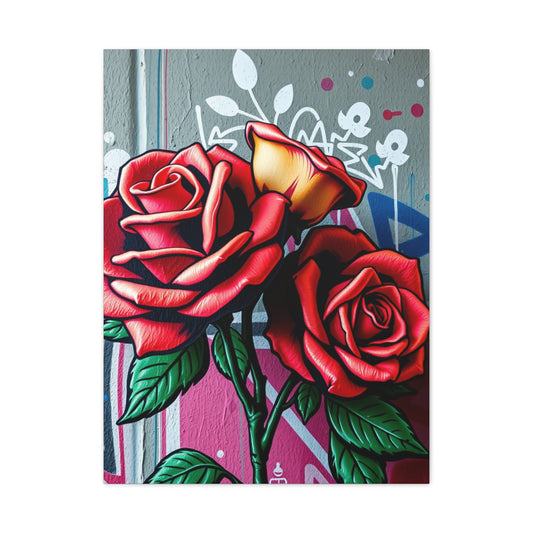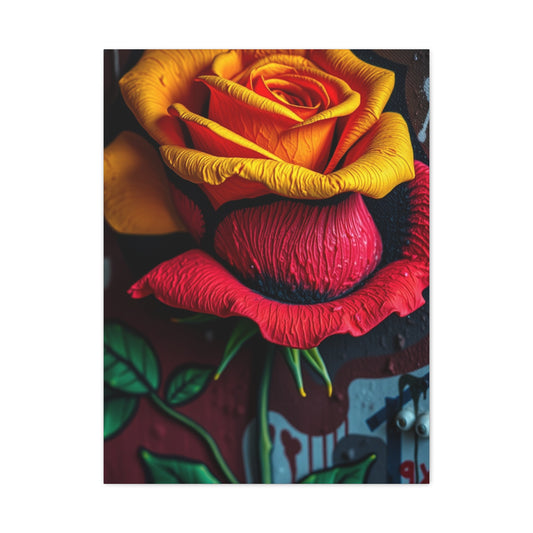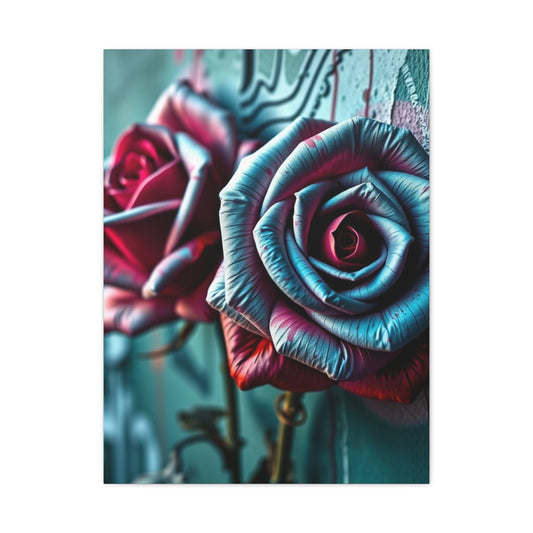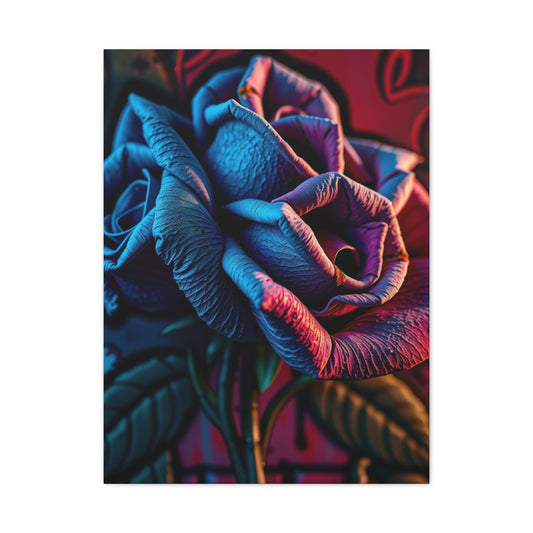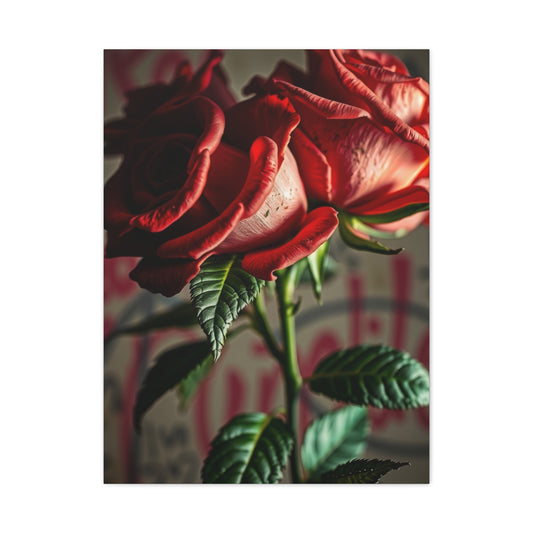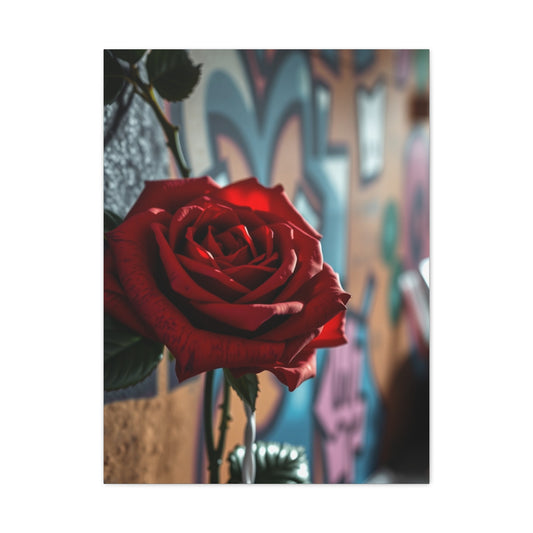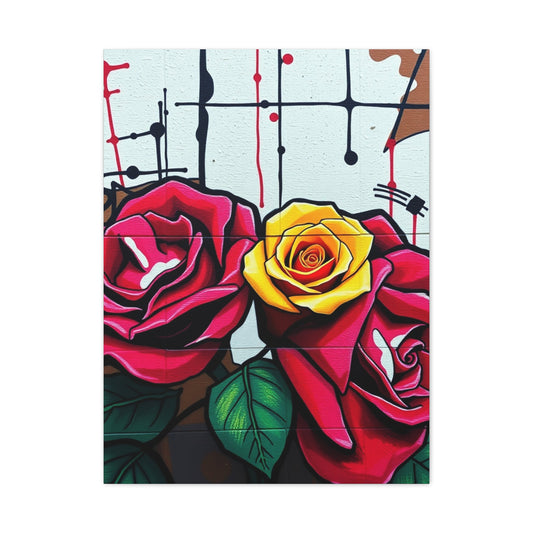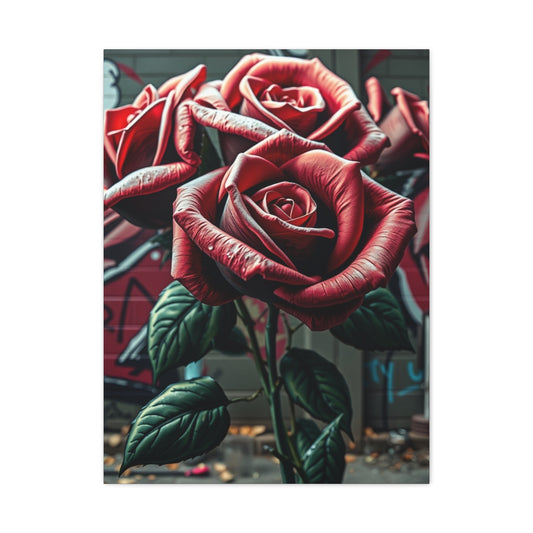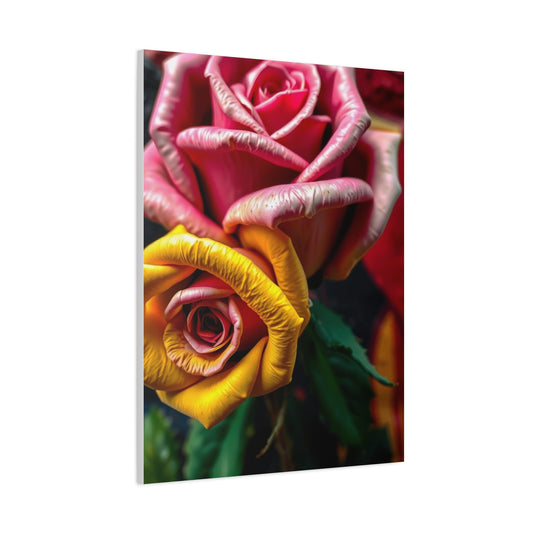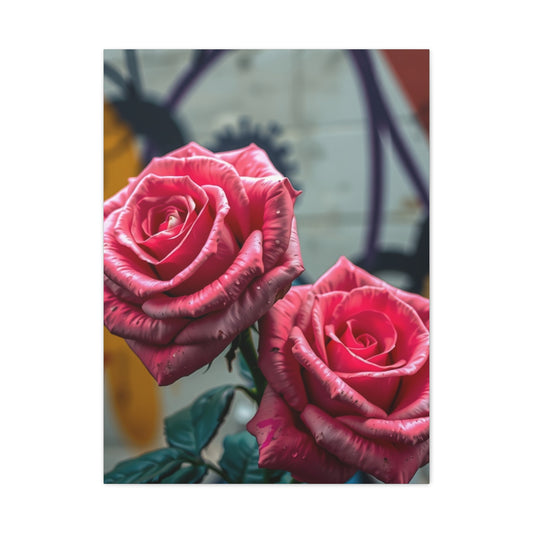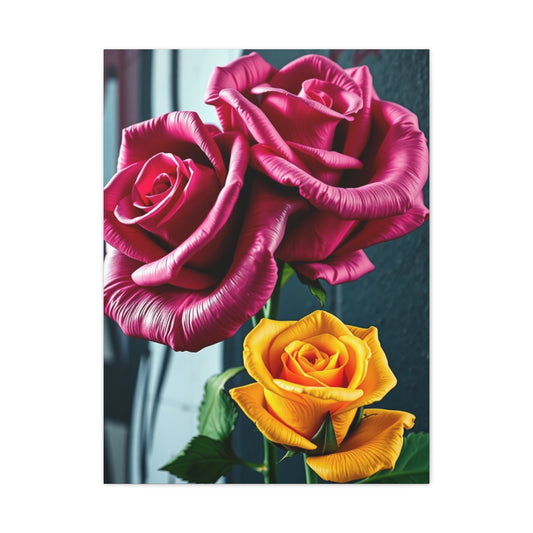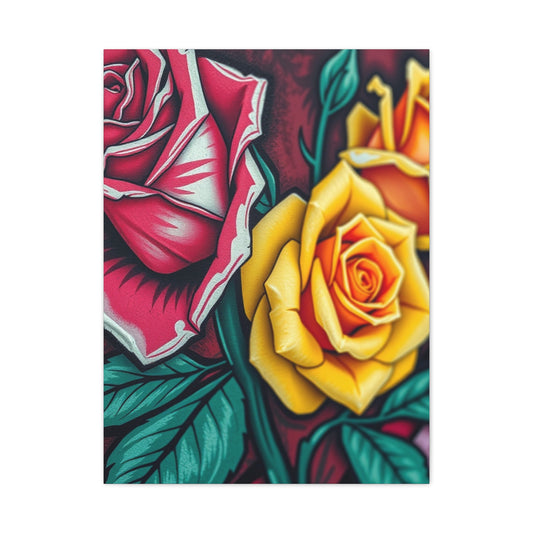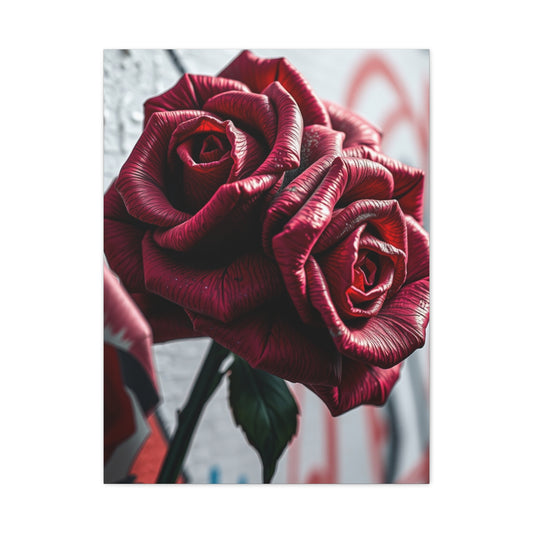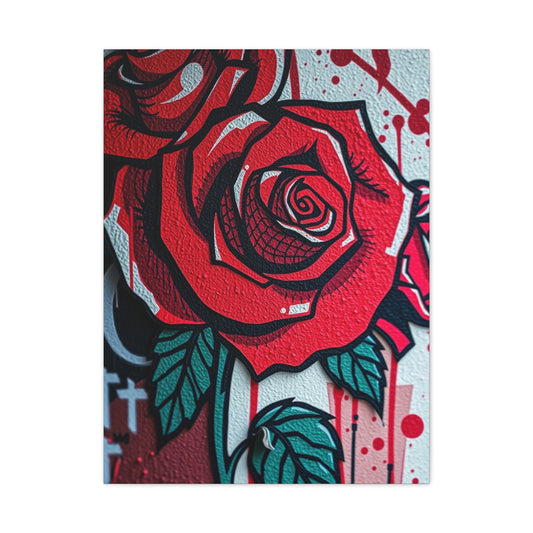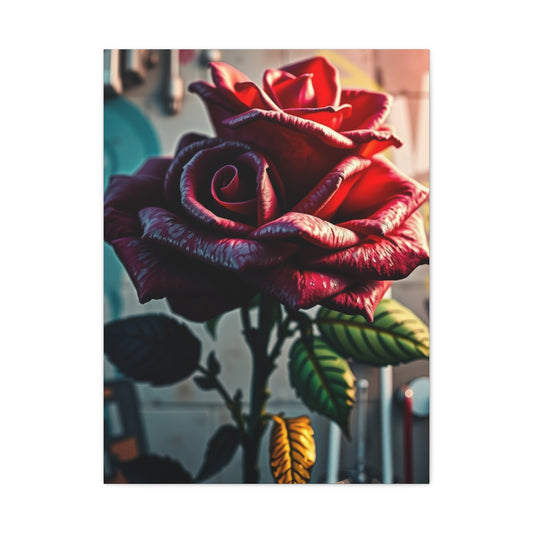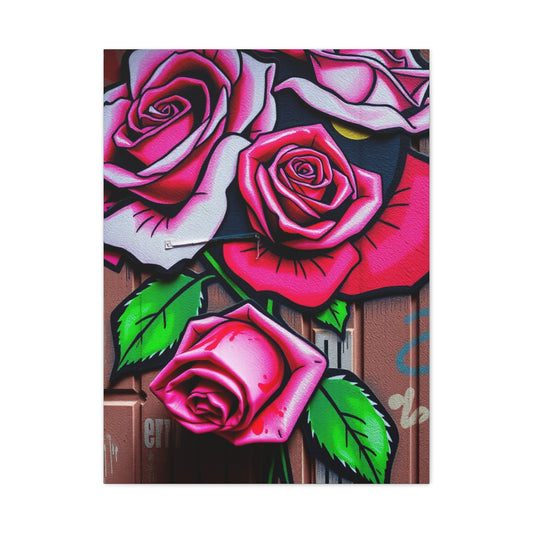Graffiti Roses: Bold, Artistic Wall Art - The Ultimate Expression of Urban Floral Design
The emergence of graffiti roses represents a groundbreaking convergence between urban street expression and botanical aesthetics. This distinctive art form transcends conventional boundaries, creating a powerful visual narrative that speaks to contemporary sensibilities while honoring both rebellious urban culture and timeless natural beauty. The phenomenon has captured the imagination of interior designers, homeowners, and art enthusiasts who seek something beyond traditional floral motifs.
Street-inspired rose imagery draws its strength from the raw energy of metropolitan environments, where concrete walls become canvases for expressive creativity. These designs incorporate the spontaneous, free-flowing characteristics of street art while maintaining the elegant sophistication inherent in rose symbolism. The result is a mesmerizing fusion that challenges preconceived notions about what constitutes appropriate interior decoration.
The artistic movement behind these urban floral pieces emerged from underground communities where artists began experimenting with juxtaposing organic forms against industrial backgrounds. This experimentation led to the development of unique visual languages that communicate both rebellion and romance, strength and delicacy. The contrast creates visual tension that immediately captures attention and maintains viewer engagement.
Contemporary interpretations of street-style roses often feature bold color palettes that deviate from natural rose hues. Electric blues, vibrant purples, neon greens, and sunset oranges replace traditional reds and pinks, creating striking visual impact that complements modern interior design schemes. These unconventional color choices reflect the fearless experimentation characteristic of street art culture.
The texturing methods employed in creating graffiti rose designs mirror those found in authentic street art. Spray paint effects, dripping techniques, and layered compositions contribute to the authentic urban aesthetic. Artists frequently incorporate elements like paint splatters, stenciled details, and weathered appearances that suggest the passage of time on city walls.
The Evolution of Graffiti Roses in Urban Art
Graffiti art has long been associated with self-expression, social commentary, and subversive creativity. Emerging from street culture, graffiti initially faced widespread criticism for its rebellious nature and association with vandalism. Over time, however, it evolved into a legitimate art form, with urban artists pushing boundaries in both technique and content. Graffiti roses exemplify this evolution, transforming the street’s raw energy into universally appreciated visual statements.
The rose, a timeless symbol of love, beauty, and passion, has been reimagined through graffiti techniques, often featuring bold lines, striking color contrasts, and layered textures. This combination creates a sense of movement and vitality, reflecting the dynamic energy of urban environments while maintaining the rose’s inherent elegance. Artists like Banksy, Fintan Magee, and local street artists worldwide have contributed to popularizing floral graffiti, using roses as both aesthetic elements and vehicles for social and cultural expression.
DIY and Personalized Graffiti Rose Projects
For homeowners, art enthusiasts, and creative hobbyists, DIY graffiti rose projects provide an exciting opportunity to personalize living spaces while embracing the bold energy of urban floral design. These projects allow individuals to experiment with colors, textures, and techniques, resulting in unique pieces that reflect both artistic vision and personal style. Beyond simple decoration, DIY graffiti roses can become focal points in a room, conversation starters, or even long-term passion projects that evolve with changing tastes.
Spray Paint Canvases remain one of the most accessible and popular DIY approaches. By using stencils, masking tape, or freehand techniques, individuals can create vibrant graffiti rose patterns on canvas, wooden panels, or even directly on walls. Spray paint offers versatility in color blending, gradients, and layering, making it possible to achieve depth and movement reminiscent of professional street art. Beginners can start with smaller canvases for tabletop displays or gallery walls, while advanced DIYers can experiment with large-scale murals that dominate an entire wall. Incorporating neon shades or metallic sprays can enhance the contemporary urban aesthetic, creating a dynamic visual impact that complements modern interiors.
Layered Collages elevate graffiti rose DIY projects by combining printed images, painted elements, textured paper, and paint splatters. This technique allows for playful experimentation with composition, color harmony, and spatial relationships, resulting in a multi-dimensional gallery-style display. Acrylic accents, foil overlays, and even fabric elements can add tactile interest, encouraging viewers to explore the piece up close. Layered collages are ideal for those who enjoy mixing traditional craft techniques with modern graffiti aesthetics, producing pieces that feel both personal and sophisticated.
Digital Art and Projection techniques bring technology into the DIY process, enabling precise, customizable graffiti rose designs. Artists can create digital sketches or illustrations on tablets and project these outlines onto walls, adjusting size, orientation, and placement with ease. This method is particularly useful for individuals who wish to replicate intricate designs or explore experimental color combinations without committing to permanent freehand painting. Digital tools also allow for iterations, ensuring that the final result aligns perfectly with the intended décor.
Mixed-Media Assemblages take DIY graffiti rose projects to the next level by incorporating three-dimensional elements. Recycled materials, 3D embellishments, metallic foils, and layered textures can transform a simple graffiti rose design into an interactive sculptural piece. These installations not only bring color and movement to a room but also invite tactile engagement, making them ideal for creative studios, children’s rooms, or eclectic living spaces.
By exploring these DIY approaches, homeowners can create custom graffiti rose artwork that aligns with personal tastes, room dimensions, and existing décor themes. These projects celebrate individuality, foster creativity, and transform ordinary walls into expressive canvases, capturing the essence of urban floral artistry in a deeply personal way.
Transforming Living Spaces with Urban Botanical Expressions
Incorporating street-style rose wall art into residential and commercial spaces requires careful consideration of existing design elements and desired atmospheric effects. These powerful visual pieces function as focal points that can dramatically alter the perceived character of any room. The key lies in understanding how these bold artistic statements interact with surrounding furnishings and architectural features.
Modern minimalist interiors provide ideal backdrops for graffiti rose installations. The stark simplicity of contemporary design creates perfect contrast conditions that allow these vibrant pieces to command attention without competing with busy patterns or excessive decorative elements. Clean lines and neutral color schemes serve as effective counterpoints to the organic, flowing forms of stylized roses.
Industrial-style spaces naturally complement street-inspired floral art due to shared aesthetic DNA. Exposed brick walls, metal fixtures, and raw concrete surfaces create authentic urban environments where graffiti roses feel organically integrated rather than artificially imposed. The rough textures and utilitarian materials enhance the rebellious character of these artistic expressions.
Color coordination strategies must account for the bold, saturated hues typically featured in street-style rose designs. Neutral base colors like whites, grays, and blacks allow vibrant rose imagery to pop dramatically without creating visual chaos. Accent colors should be selected carefully to either complement or provide strategic contrast without overwhelming the space.
Lighting considerations play crucial roles in showcasing graffiti rose wall art effectively. Direct spotlighting can create dramatic shadows and highlights that enhance the three-dimensional qualities of layered compositions. Ambient lighting should be adjusted to prevent color washout while maintaining adequate illumination for appreciating intricate details and subtle color variations.
Scale and proportion require careful evaluation when selecting pieces for specific spaces. Oversized graffiti rose installations can dominate small rooms, while undersized pieces may disappear in expansive areas. The goal is achieving visual balance that allows the art to enhance rather than overwhelm the existing spatial dynamics.
Contemporary Design Philosophy Behind Street Floral Art
The philosophical foundations underlying graffiti rose art reflect broader cultural shifts toward embracing contradictions and celebrating diversity. This movement challenges traditional categorizations that separate "high" and "low" art forms, creating space for expressions that draw inspiration from both refined botanical illustration and raw street culture.
Postmodern design principles heavily influence the development of street-style floral art. The deliberate mixing of seemingly incompatible elements—urban grit and natural beauty—exemplifies postmodern sensibilities that reject rigid categorizations in favor of fluid, hybrid expressions. This philosophical approach resonates with contemporary audiences who appreciate complexity and authenticity over simplistic categorizations.
The democratization of art through street expression has always been central to graffiti culture. Street-style roses continue this tradition by making sophisticated artistic concepts accessible to broader audiences. Unlike traditional fine art that often requires extensive cultural knowledge for full appreciation, these pieces communicate immediately and viscerally to viewers regardless of their artistic background.
Sustainability consciousness increasingly influences contemporary art movements, including street-inspired floral design. Many artists working in this genre prioritize eco-friendly materials and production methods, reflecting growing awareness of environmental responsibilities. Digital printing on recycled materials, water-based inks, and locally sourced substrates represent common sustainable practices.
The intersection of digital and analog creation methods characterizes modern graffiti rose production. Artists frequently begin with hand-drawn sketches or spray-painted originals, then digitize and manipulate these images using sophisticated software. This hybrid approach allows for unlimited reproduction possibilities while maintaining the authentic character of handmade originals.
Cultural authenticity remains a primary concern within the street art community. Legitimate graffiti rose art maintains connections to genuine street culture rather than superficially appropriating visual elements for commercial purposes. Understanding this distinction helps consumers identify pieces that honor the artistic tradition rather than exploiting it.
Color Theory and Visual Impact in Urban Rose Design
The strategic deployment of color in graffiti rose designs requires sophisticated understanding of visual psychology and chromatic relationships. Unlike traditional botanical art that relies on naturalistic color palettes, street-inspired rose imagery embraces bold, unconventional hues that create immediate emotional responses and lasting visual impressions.
Complementary color schemes feature prominently in effective graffiti rose compositions. The deliberate pairing of opposite colors on the color wheel—such as electric blue roses against orange backgrounds—creates maximum visual contrast and energy. These high-contrast combinations mirror the attention-grabbing nature of authentic street art while maintaining aesthetic sophistication.
Analogous color progressions offer alternative approaches for creating harmonious yet dynamic compositions. Gradual transitions between related hues—purple moving through magenta to hot pink—create flowing visual movements that guide viewer attention across the composition. These subtle color relationships can create more contemplative, meditative effects compared to high-contrast alternatives.
Monochromatic variations explore the full range of single hue families, from deepest shadows to brightest highlights. Black and white graffiti roses with selective color accents represent particularly popular approaches that combine graphic boldness with restrained sophistication. These limited palettes work exceptionally well in contemporary interior design schemes that emphasize clean, uncluttered aesthetics.
The psychological effects of specific color choices significantly impact viewer responses to graffiti rose art. Warm colors like reds, oranges, and yellows create energetic, stimulating atmospheres that encourage active engagement and social interaction. Cool blues, greens, and purples promote calming, contemplative moods that support relaxation and introspection.
Metallic accents increasingly appear in contemporary graffiti rose designs, adding luxury elements that elevate street art aesthetics toward more refined territories. Gold, silver, and copper highlights create sophisticated shimmer effects that change appearance under different lighting conditions, adding dynamic visual interest throughout the day.
Cultural Significance and Artistic Heritage
The cultural roots of graffiti rose art extend deep into urban communities where street expression has long served as voice for marginalized populations. Understanding this heritage provides essential context for appreciating these works as legitimate artistic expressions rather than mere decorative objects divorced from their cultural origins.
Hip-hop culture significantly influenced the development of contemporary graffiti aesthetics, including the emergence of floral motifs within street art vocabulary. The four pillars of hip-hop—MCing, DJing, breaking, and graffiti—created comprehensive cultural frameworks that celebrated creativity, authenticity, and community connection. Graffiti roses represent evolution within this tradition rather than departure from it.
Feminist perspectives within street art have contributed to the increasing prominence of floral imagery in urban environments traditionally dominated by masculine themes. Female artists have reclaimed and reinterpreted rose symbolism, transforming these flowers from passive romantic tokens into powerful statements of strength, resilience, and beauty existing on their own terms.
Latin American muralism traditions influence contemporary graffiti rose aesthetics through their emphasis on bold colors, social messaging, and community engagement. The fusion of indigenous artistic traditions with modern street culture creates unique visual languages that speak to diverse cultural experiences while maintaining universal appeal.
International variations in graffiti rose styles reflect local cultural influences and artistic traditions. European approaches often emphasize technical precision and classical proportions, while African-influenced styles celebrate bold patterns and symbolic meanings. Asian interpretations frequently incorporate calligraphic elements and philosophical concepts that add layers of meaning beyond pure visual appeal.
The commercialization of street art raises important questions about cultural appropriation and artistic authenticity. Legitimate graffiti rose art maintains connections to genuine street culture through artist credentials, community involvement, and respect for the medium's rebellious origins. Understanding these distinctions helps consumers make informed choices that support authentic artistic expression.
Interior Design Integration Strategies
Successfully incorporating graffiti rose wall art into interior design schemes requires understanding how these bold artistic statements interact with existing furniture, lighting, and architectural elements. The goal is creating cohesive environments where urban floral art enhances rather than conflicts with overall design objectives.
Color coordination represents the most critical factor in successful integration. Graffiti rose pieces featuring bold, saturated hues require careful consideration of surrounding color palettes to prevent visual chaos. Neutral base schemes in whites, grays, and blacks provide ideal foundations that allow vibrant art to serve as dramatic focal points without competing with busy patterns or conflicting colors.
Furniture selection should complement rather than compete with statement wall art. Simple, clean-lined pieces in solid colors work best with bold graffiti rose installations. Overly ornate or busy furniture patterns can create visual noise that diminishes the impact of the wall art while creating chaotic, uncomfortable environments.
Textile choices throughout the space should support the urban aesthetic without directly mimicking it. Industrial materials like leather, metal, and raw wood naturally complement street-inspired art, while soft textures in neutral colors provide necessary balance. Avoid floral patterns in fabrics and rugs that might compete with or trivialize the wall art.
Architectural integration opportunities should be explored during the design planning phase. Features like exposed brick walls, concrete surfaces, and metal fixtures enhance the authentic urban feel that makes graffiti roses feel naturally integrated rather than artificially imposed. These elements reinforce the street art aesthetic while providing textural interest.
Scale relationships between wall art and room dimensions require careful evaluation. Oversized pieces can overwhelm small spaces, while undersized art disappears in large rooms. Professional designers often recommend artwork that occupies roughly 60-75% of available wall space to achieve proper visual balance and impact.
Modern Production Methods and Material Considerations
Contemporary graffiti rose wall art production employs sophisticated printing and manufacturing techniques that ensure vibrant colors, sharp details, and long-lasting durability. Understanding these production methods helps consumers make informed decisions about quality levels and expected longevity of their artistic investments.
Digital printing technologies enable precise color reproduction and unlimited scalability for graffiti rose designs. High-resolution inkjet printers using archival pigment inks produce museum-quality prints that resist fading for decades when properly displayed. UV-resistant coatings provide additional protection against sunlight damage in bright environments.
Substrate materials significantly impact both appearance and longevity of finished pieces. Canvas remains the most popular choice for its traditional fine art associations and proven durability. Heavy-weight cotton or linen canvases provide stable foundations that resist warping and maintain tight stretching over time. Synthetic alternatives offer improved moisture resistance for humid environments.
Vinyl applications require specialized materials designed for long-term wall adhesion. High-quality architectural vinyls feature aggressive adhesives that bond permanently with painted surfaces while remaining removable without damage. Laminated surfaces protect printed images from scratching and moisture while maintaining vibrant appearance.
Metal substrates increasingly appear in contemporary graffiti rose installations, particularly aluminum and steel panels that complement industrial design aesthetics. Direct printing on metal creates unique visual effects with enhanced color saturation and metallic reflections. These durable substrates resist environmental damage while providing contemporary alternatives to traditional canvas presentations.
Quality control measures ensure consistent results across production runs. Color management systems maintain accurate hue reproduction from digital files to finished prints. Regular calibration of printing equipment prevents drift in color accuracy over time. Inspection protocols identify and eliminate defective pieces before shipping.
Psychological Effects and Emotional Responses
The psychological impact of graffiti rose wall art extends far beyond simple aesthetic appreciation, triggering complex emotional responses that can significantly influence mood, creativity, and overall well-being within interior environments. Understanding these effects helps explain the growing popularity of street-inspired floral art in both residential and commercial applications.
Color psychology research demonstrates measurable effects of specific hues on human behavior and emotional states. The vibrant, saturated colors typical of graffiti rose art stimulate neural pathways associated with energy, creativity, and positive emotional responses. Unlike muted, traditional color schemes that promote calm but potentially passive states, bold urban florals encourage active engagement and dynamic thinking.
The juxtaposition of organic floral forms with urban aesthetic elements creates cognitive tension that maintains viewer interest and stimulates creative thinking. This visual complexity requires active mental processing that can enhance problem-solving abilities and encourage innovative approaches to challenges. The effect is particularly pronounced in work environments where creative thinking is valued.
Biophilic design principles suggest that human beings possess innate connections to natural forms and patterns. Graffiti roses satisfy these biological needs while simultaneously appealing to contemporary cultural sensibilities that value authenticity and rebellion against conventional norms. This dual appeal creates particularly satisfying psychological experiences.
Social identity considerations influence responses to street-inspired art in personal spaces. Displaying graffiti rose art communicates specific values and aesthetic preferences that reflect individual personality and cultural affiliations. For many, these pieces represent rejection of conventional decoration in favor of more authentic, personally meaningful expressions.
Stress reduction benefits may result from exposure to artistic expressions that provide emotional outlets and creative stimulation. The rebellious nature of street art can offer vicarious experiences of freedom and self-expression for individuals constrained by conventional social or professional expectations. This psychological release contributes to overall mental health and life satisfaction.
Customization and Personalization Options
The flexibility of digital production methods enables extensive customization opportunities for graffiti rose wall art, allowing customers to create truly unique pieces that reflect personal tastes, spatial requirements, and specific design objectives. This personalization capability represents significant advantages over traditional mass-produced decorative options.
Color customization allows customers to adapt existing designs to match specific interior color schemes or personal preferences. Digital manipulation techniques enable artists to adjust hues, saturation levels, and contrast ratios while maintaining the artistic integrity of original compositions. This flexibility ensures perfect integration with existing decor elements.
Size modifications accommodate diverse spatial requirements from small accent pieces to room-spanning murals. Scalable vector-based designs maintain sharp details and color accuracy across any size range. Professional design consultation helps determine optimal dimensions for specific wall spaces and viewing distances.
Text integration options allow personalization with names, quotes, dates, or meaningful phrases incorporated into graffiti rose designs. Custom typography matching the urban aesthetic maintains visual coherence while adding personal significance. Popular applications include wedding gifts, anniversary commemorations, and inspirational messaging.
Compositional modifications enable adjustment of element placement, density, and arrangement to suit specific architectural features or design requirements. Artists can adapt existing designs to work around obstacles like switches, outlets, or irregular wall shapes while maintaining visual balance and impact.
Background customization provides alternatives to standard approaches, incorporating elements like brick textures, concrete surfaces, or abstract patterns that enhance the urban aesthetic. These modifications can help integrate artwork more effectively with existing architectural features or desired atmospheric effects.
Creating Cohesive Multi-Piece Installations
Large-scale graffiti rose installations often benefit from coordinated multi-piece approaches that create immersive environments rather than isolated decorative elements. Strategic planning and design coordination ensure visual harmony while maintaining individual piece distinctiveness that prevents monotonous repetition.
Series development begins with establishing unifying elements like color palettes, stylistic approaches, or thematic content that connect individual pieces while allowing variation in composition, scale, and specific details. This balance creates visual relationships without redundancy that might diminish overall impact.
Spatial distribution strategies consider viewing angles, lighting conditions, and traffic patterns to optimize visual impact and viewer engagement. Sequential arrangement can guide attention flow through spaces while strategic focal points create rest areas for extended contemplation.
Scale variations within multi-piece installations create visual rhythm and hierarchy that prevents monotonous uniformity. Alternating large statement pieces with smaller accent works creates dynamic compositions that maintain interest while providing flexibility for different wall sizes and architectural features.
Color progression techniques can unify multi-piece installations through gradual transitions between related hues or systematic variations in saturation and value. These subtle relationships create cohesive appearances while maintaining individual piece identity and visual interest.
Thematic development allows multi-piece installations to tell visual stories or explore concept variations that provide intellectual engagement beyond pure aesthetic appreciation. Narrative elements can reflect personal experiences, cultural themes, or abstract philosophical concepts that add meaning layers to decorative functions.
Professional vs. DIY Installation Considerations
The decision between professional installation and do-it-yourself approaches for graffiti rose wall art depends on multiple factors including artwork type, wall conditions, skill levels, and budget constraints. Understanding the advantages and limitations of each approach helps ensure successful outcomes regardless of chosen method.
Professional installation guarantees expert technique application, proper tool usage, and quality results that protect both artwork and wall surfaces. Experienced installers understand material properties, adhesive characteristics, and environmental factors that affect long-term performance. Insurance coverage protects against installation damage or defects.
DIY approaches offer cost savings and personal satisfaction for capable individuals with appropriate tools and sufficient time. Simple vinyl decals and smaller canvas pieces often suit DIY installation, while complex murals or large-scale pieces typically require professional expertise to achieve satisfactory results.
Tool requirements vary significantly between installation methods. Basic vinyl applications need measuring tools, squeegees, and cutting implements, while canvas mounting requires levels, stud finders, hanging hardware, and possibly frame construction skills. Professional tools often produce superior results but represent additional investment costs.
Skill assessment helps determine realistic DIY capability levels. Measuring accuracy, level installation, and surface preparation require basic construction skills that many homeowners possess. Complex layouts, custom framing, or problem wall conditions typically exceed amateur capabilities and warrant professional assistance.
Warranty considerations may influence installation method choices. Professional installations often include performance guarantees and correction services for problems that develop over time. DIY installations place full responsibility on the homeowner for addressing any issues that arise after completion.
Lighting Design for Optimal Art Display
Strategic lighting design significantly enhances the visual impact and appreciation of graffiti rose wall art while protecting valuable pieces from damage caused by inappropriate illumination levels or heat exposure. Understanding lighting principles helps create dramatic presentations that showcase artistic details effectively.
Track lighting systems provide flexibility for adjusting illumination angles and intensity levels to complement changing exhibitions or seasonal preferences. Adjustable heads enable precise control over light distribution patterns while integrated dimming capabilities accommodate different usage scenarios and atmospheric requirements.
Picture lighting mounted directly above or below artwork pieces creates focused illumination that minimizes shadows while providing dramatic accent effects. LED picture lights offer energy efficiency and minimal heat production that protects artwork from thermal damage while providing consistent color temperature over extended operational periods.
Ambient lighting considerations ensure adequate general illumination that allows comfortable navigation and social interaction without competing with accent lighting focused on artwork. Balanced lighting schemes prevent excessive contrast that can strain viewer eyes while maintaining focus on featured pieces.
Color temperature selection affects perception of artwork colors and overall atmospheric qualities. Warm white lighting enhances red and orange tones while potentially muting blues and greens. Cool white lighting provides more accurate color rendition for diverse color palettes but may create less cozy atmospheric effects.
UV filtering becomes critical for protecting valuable artwork from photochemical damage that causes color fading and material degradation over time. LED lighting systems typically produce minimal UV radiation, while halogen and fluorescent sources require UV-filtering covers or specialized bulbs designed for museum applications.
Space Planning and Layout Optimization
Effective space planning maximizes the visual impact of graffiti rose wall art while maintaining functional circulation patterns and comfortable human scale relationships throughout interior environments. Strategic placement considerations address both aesthetic objectives and practical usage requirements.
Focal point development identifies primary viewing locations and sight lines that determine optimal artwork placement for maximum visual impact. Entry points, seating areas, and high-traffic zones represent prime locations that ensure regular exposure and appreciation by occupants and visitors.
Wall space analysis evaluates available surfaces considering architectural features, furniture placement, and functional requirements that might limit installation options. Electrical outlets, switches, and HVAC vents require integration into layout planning to avoid conflicts or compromise installations.
Traffic pattern evaluation ensures artwork placement doesn't interfere with natural movement flows while providing adequate viewing distances for proper appreciation. Narrow hallways may require smaller pieces or strategic placement that accommodates passing traffic without crowding.
Furniture relationship planning considers how seating arrangements, tables, and storage elements interact with wall art placement. Sofas and chairs positioned for artwork viewing enhance appreciation opportunities while poor relationships can block sight lines or create uncomfortable neck positions.
Ceiling height considerations influence artwork scale and placement decisions. High ceilings can accommodate larger pieces and elevated mounting positions that create dramatic effects, while standard residential heights may require careful scale selection to maintain proper proportions.
Cultural Sensitivity and Authentic Representation
The intersection of street art culture with commercial interior design raises important questions about cultural authenticity, appropriation, and respectful representation of artistic traditions that emerged from specific social and cultural contexts. Understanding these considerations helps consumers make ethical choices that honor artistic heritage.
Artist credibility represents a fundamental consideration when selecting graffiti rose artwork. Legitimate pieces should demonstrate connections to authentic street art culture through artist backgrounds, community involvement, or collaborative relationships with established street artists. Surface-level imitation without cultural understanding risks trivializing important artistic movements.
Community impact considerations examine how commercial success of street-inspired art benefits or exploits the communities that originated these artistic forms. Ethical purchasing supports artists and organizations that reinvest in urban communities rather than extracting cultural capital for purely commercial purposes.
Historical context education helps consumers understand the social and political circumstances that gave rise to street art movements. This knowledge provides appreciation frameworks that go beyond surface aesthetics to encompass deeper cultural meanings and contemporary relevance.
Respectful integration approaches honor the rebellious spirit of street art while adapting it appropriately for different contexts. Maintaining edge and authenticity without promoting inappropriate messages or glorifying destructive behaviors requires careful balance and cultural sensitivity.
Contemporary relevance ensures that street-inspired art continues evolving rather than becoming fossilized representations of past movements. Living artistic traditions adapt to current issues and cultural contexts while maintaining connections to foundational principles and aesthetic approaches.
Health and Safety Considerations
Installation and long-term display of graffiti rose wall art requires attention to health and safety factors that protect both installers and occupants from potential hazards associated with materials, chemicals, and installation processes. Understanding these considerations ensures safe enjoyment of artistic installations.
Indoor air quality impacts result from materials used in artwork production and installation processes. High-quality, low-VOC inks and substrates minimize chemical off-gassing that can affect sensitive individuals. Proper ventilation during installation helps dissipate any temporary chemical odors from adhesives or protective coatings.
Adhesive safety considerations address both installation hazards and long-term exposure concerns. Professional-grade vinyl adhesives may require protective equipment during application but pose minimal risks after curing. Solvent-based products require adequate ventilation and may be inappropriate for sensitive environments like nurseries or healthcare facilities.
Fire safety evaluations consider flammability characteristics of different materials and their compliance with local building codes. Vinyl installations typically meet fire safety standards for residential applications, while some specialized materials may require flame retardant treatments for commercial use.
Structural considerations ensure that wall-mounting systems can safely support artwork weights without compromising wall integrity or creating falling hazards. Professional installation includes appropriate anchoring for wall types and artwork weights with safety margins that exceed minimum requirements.
Child safety measures address potential hazards in homes with young children who might interact with wall art installations. Smooth edges, secure mounting, and non-toxic materials help prevent injuries while placement above reach zones reduces interaction opportunities.
Seasonal Adaptation and Refresh Strategies
The flexibility of modern graffiti rose wall art enables seasonal updates and refreshment strategies that maintain visual interest while accommodating changing preferences, trends, or life circumstances. Planning for adaptability from the initial installation provides long-term satisfaction and value.
Removable installation methods facilitate seasonal changes without permanent wall modifications. High-quality vinyl systems enable complete replacement with different designs while magnetic mounting systems allow quick exchanges that accommodate holiday themes or seasonal color preferences.
Color rotation strategies maintain core design elements while introducing seasonal color variations that reflect changing natural cycles or holiday celebrations. Spring installations might emphasize fresh greens and vibrant pinks, while autumn versions could feature warm oranges and deep reds.
Accent piece additions provide economical refresh options that update existing installations without complete replacement. Small vinyl accents, additional canvas pieces, or complementary decorative elements can transform the overall appearance while preserving major artistic investments.
Lighting modifications offer simple methods for creating seasonal atmospheric changes. Color-changing LED systems enable dramatic transformations that align with holidays, seasons, or special events while maintaining the same base artwork installation.
Storage solutions for alternate pieces enable cost-effective seasonal rotation programs. Proper storage protects unused artwork from damage while organized systems facilitate easy access when rotation schedules require changes.
Investment Value and Long-Term Considerations
Graffiti rose wall art represents both aesthetic enhancement and potential financial investment that may appreciate over time, particularly for pieces created by recognized artists or representing significant cultural movements. Understanding investment aspects helps inform purchase decisions and care practices.
Artist reputation development affects long-term value appreciation potential. Emerging artists working in street-inspired genres may gain recognition that increases their work value, while established artists already command premium prices that reflect proven market demand.
Edition sizes and reproduction limitations influence value retention for printed works. Limited edition pieces typically maintain higher values than unlimited reproductions, while original paintings represent unique investments with greatest appreciation potential.
Market trend analysis suggests growing acceptance and demand for street-inspired art across diverse demographic segments. Mainstream adoption of urban aesthetic elements in commercial and residential design indicates potential for continued value growth.
Condition preservation directly impacts long-term value retention. Professional installation, appropriate environmental controls, and regular maintenance help ensure artwork remains in excellent condition that supports maximum resale value if desired.
Documentation importance includes maintaining records of artist credentials, edition information, purchase documentation, and condition reports that support authenticity claims and value assessments for insurance or resale purposes.
Global Influences and Cross-Cultural Adaptations
The international spread of graffiti rose art reflects globalization's impact on artistic expression while demonstrating how universal themes like beauty, rebellion, and self-expression transcend cultural boundaries. Understanding these global influences enriches appreciation for artistic diversity and cultural exchange.
European interpretations often emphasize technical precision and classical proportions that reflect centuries of artistic tradition while incorporating contemporary street aesthetics. The result combines old-world sophistication with modern urban energy in uniquely European expressions.
Asian adaptations frequently incorporate calligraphic elements, symbolic meanings, and philosophical concepts that add intellectual depth to visual appeal. Traditional color symbolism and seasonal associations create culturally specific meanings that enhance universal appreciation.
Latin American influences bring vibrant color traditions, folk art elements, and social consciousness that reflect indigenous heritage combined with contemporary urban experience. These pieces often carry deeper cultural messages alongside aesthetic appeal.
African inspirations celebrate pattern traditions, symbolic storytelling, and community values that transform individual artistic expression into collective cultural communication. Bold patterns and symbolic meanings create rich visual and intellectual experiences.
North American developments reflect diverse cultural influences within cosmopolitan urban environments where multiple traditions interact and merge. The result often represents synthesized approaches that draw from many sources while creating distinctly American expressions.
Conclusion
The remarkable evolution of graffiti rose wall art represents far more than a mere decorative trend; it embodies a profound cultural shift toward embracing authenticity, celebrating diversity, and rejecting conventional aesthetic boundaries. This artistic movement has successfully bridged the gap between rebellious street culture and sophisticated interior design, creating a new category of wall art that speaks to contemporary sensibilities while honoring both natural beauty and urban creativity.
Throughout this comprehensive exploration, we have witnessed how graffiti roses transform ordinary living and working spaces into dynamic environments that stimulate creativity, encourage personal expression, and foster emotional connections. The psychological impact of these bold artistic statements extends well beyond visual appeal, influencing mood, productivity, and overall well-being in measurable ways that justify their growing popularity across diverse demographic segments.
The technical aspects of production, installation, and maintenance have evolved to meet professional standards that ensure longevity, color accuracy, and structural integrity. Modern printing technologies, sophisticated materials, and proven installation methods have elevated street-inspired art from temporary expressions to permanent architectural elements worthy of significant investment and careful preservation.
Cultural considerations remain paramount in the ethical development and consumption of graffiti rose art. Authentic pieces that honor the rebellious spirit and community origins of street art culture provide meaningful connections to important artistic movements while avoiding superficial appropriation that trivializes these traditions. The most successful installations maintain this cultural authenticity while adapting appropriately to diverse contexts and applications.
The versatility of graffiti rose art accommodates an extraordinary range of applications, from intimate residential spaces to expansive commercial installations. This adaptability reflects the universal appeal of combining natural beauty with urban authenticity, creating visual experiences that resonate across cultural, generational, and socioeconomic boundaries. The customization possibilities ensure that each installation can reflect individual personality while participating in broader cultural movements.
Market trends indicate continued growth and evolution in street-inspired floral art as younger generations assume greater influence over aesthetic preferences and spending decisions. The integration of digital production methods, sustainable materials, and innovative installation techniques positions this artistic category for continued expansion and refinement that will meet evolving consumer expectations while maintaining cultural relevance.

